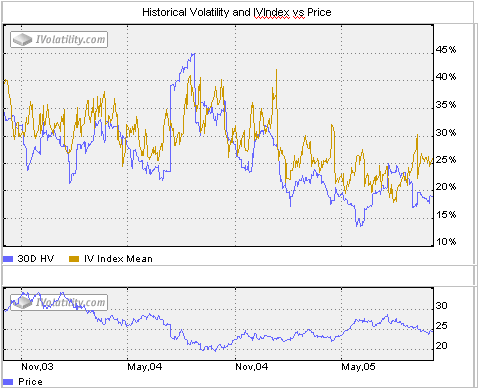Do you buy options? Here’s how to pick the right ones…
Editor’s note: We’d like to take this
opportunity to welcome professional options trader Adam Warner. For over a
decade, Adam was an options market maker on the floor of the AMEX. He currently
is a proprietary trader specializing in options and derivative strategies.
When you boil it
all down, options “bets†take two forms. In one
form you are “betting†on the direction of the underlying product, be it a
stock, bond, index, ETF, or whatever. In the other form, you are betting on the
volatility of the underlying instrument. I’ll deal with both over the course of
time, but for today’s purposes I’m going to look at the latter–volatility
trading. What makes me want to go “long†volatility in a specific name?
First, what does it mean to be “long†volatility? Basically, it’s when you are a
net owner of options in a given name. If the name goes higher, your share
equivalent position (delta) gets longer, and if the name goes lower, it’s the
reverse, you get shorter. Sounds great, huh? The higher it goes, the longer you
get; it’s a momo dream. But alas, there are costs.
Namely, it costs money in the form of daily options decay. As each minute and
each hour and each day go by, your options are worth less and less, and ergo you
constantly fight the clock. In addition, you are at risk that the implied
volatility of the options will decline, essentially a mass prediction in the
marketplace that the underlying stock will not fluctuate to as great an extent
as previously thought.
So net-buying options has clear risk (time decay and volatility declines) and
reward (nice price action). So when do I like to net-buy?
There’s no one set formula, but as a general rule, I avoid bottom fishing in
volatility. I want to buy options into an uptrending or steady volatility chart.
Take this volatility picture of Valero
(
VLO |
Quote |
Chart |
News |
PowerRating), courtesy of ivolatility,.com:

The yellow line represents the implied volatility of the options, the blue line
represents the volatility of the stock itself. As VLO rallied over the past
year, option volatility fluctuated within a range of 30 to 45, consistent with
the volatility of the stock itself. This tells me it’s a decent name in general
in which to net-own options and try to earn money by fading the stock itself,
and with a current volatility reading of 35, it ok timing to do so as well.
Now contrast that with one of yesterday’s option darlings, Intel.

Implied option volatility has held steady here too, at least for the last 9
month’s, but its generally downtrending and consistently overpriced relative to
the volatility of the stock itself. In other words, when Intel volatility first
hit 25 at the start of 2005, it was a historically low level for Intel options.
But as you can see, the stock just hasn’t fluctuated widely enough to ever make
options ownership a winning play. Of course past performance does not predict
future results, but by the same token, why bother here to begin with and
anticipate some hypothetical activity in the stock somewhere down the road? Its
dead money until proven otherwise.
Adam Warner
https://adamsoptions.blogspot.com/
Adam Warner is a proprietary trader for
Addormar Co., Inc., specializing in option and derivative strategies. Prior to
Addormar, he was an equity options market maker on the floor of the American
Stock Exchange from 1988-2001.
